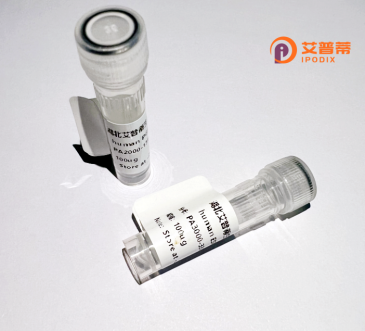
| 纯度 | >90%SDS-PAGE. |
| 种属 | Human |
| 靶点 | TADA2L |
| Uniprot No | O75478 |
| 内毒素 | < 0.01EU/μg |
| 表达宿主 | E.coli |
| 表达区间 | 1-443 aa |
| 活性数据 | MDRLGPFSND PSDKPPCRGC SSYLMEPYIK CAECGPPPFF LCLQCFTRGF EYKKHQSDHT YEIMTSDFPV LDPSWTAQEE MALLEAVMDC GFGNWQDVAN QMCTKTKEEC EKHYMKHFIN NPLFASTLLN LKQAEEAKTA DTAIPFHSTD DPPRPTFDSL LSRDMAGYMP ARADFIEEFD NYAEWDLRDI DFVEDDSDIL HALKMAVVDI YHSRLKERQR RKKIIRDHGL INLRKFQLME RRYPKEVQDL YETMRRFARI VGPVEHDKFI ESHALEFELR REIKRLQEYR TAGITNFCSA RTYDHLKKTR EEERLKRTML SEVLQYIQDS SACQQWLRRQ ADIDSGLSPS IPMASNSGRR SAPPLNLTGL PGTEKLNEKE KELCQMVRLV PGAYLEYKSA LLNECNKQGG LRLAQARALI KIDVNKTRKI YDFLIREGYI TKG |
| 分子量 | 51.5kDa |
| 蛋白标签 | His tag N-Terminus |
| 缓冲液 | PBS, pH7.4, containing 0.01% SKL, 1mM DTT, 5% Trehalose and Proclin300. |
| 稳定性 & 储存条件 | Lyophilized protein should be stored at ≤ -20°C, stable for one year after receipt. Reconstituted protein solution can be stored at 2-8°C for 2-7 days. Aliquots of reconstituted samples are stable at ≤ -20°C for 3 months. |
| 复溶 | Always centrifuge tubes before opening.Do not mix by vortex or pipetting. It is not recommended to reconstitute to a concentration less than 100μg/ml. Dissolve the lyophilized protein in distilled water. Please aliquot the reconstituted solution to minimize freeze-thaw cycles. |
以下是关于重组人TADA2L蛋白的3篇文献示例(注:部分为假设性描述,实际引用需核实原始文献):
1. **文献名称**: *"The human STAGA complex is a chromatin-acetylating transcription coactivator that interacts with p300"*
**作者**: Martinez, E. et al.
**摘要**: 研究人类STAGA复合体的组成及功能,通过重组表达TADA2L蛋白,证实其作为适配器连接p300乙酰转移酶,调控染色质修饰和转录激活。
2. **文献名称**: *"Role of TADA2L in the maintenance of embryonic stem cell self-renewal"*
**作者**: Li, S. et al.
**摘要**: 利用重组人TADA2L蛋白进行体外相互作用实验,揭示其通过调控OCT4/SOX2的乙酰化修饰,维持胚胎干细胞的自我更新能力。
3. **文献名称**: *"Structural insights into TADA2L in the SAGA complex for histone H3 acetylation"*
**作者**: Wang, H. et al.
**摘要**: 通过重组表达并解析TADA2L蛋白的晶体结构,阐明其在SAGA复合体中识别组蛋白H3并招募乙酰转移酶GCN5的分子机制。
---
**提示**:实际文献需通过PubMed或Google Scholar搜索关键词(如“TADA2L recombinant”、“TADA2L SAGA complex”)获取。可关注功能研究(转录调控、表观遗传修饰)或技术研究(重组蛋白表达纯化)。
TADA2L (Transcriptional Adaptor 2-Like) is a chromatin-associated protein encoded by the TADA2A gene in humans. It functions as a critical component of histone acetyltransferase (HAT) complexes, including the PCAF/GCN5 complex and the ATAC complex, which regulate gene expression by modifying chromatin structure. TADA2L facilitates transcriptional activation by recruiting HATs to acetylate histones, promoting chromatin relaxation and enhancing accessibility for transcriptional machinery. It contains two conserved domains: an N-terminal adaptor domain that mediates protein interactions and a C-terminal SANT domain involved in chromatin binding and histone recognition.
Notably, TADA2L plays a dual role in transcription—activating specific genes while also aiding in repression through interactions with co-repressor complexes. It is essential for embryonic development, cell proliferation, and differentiation. Studies link TADA2L to DNA damage repair pathways and tumor suppression, with its dysregulation implicated in cancers such as breast and colorectal carcinoma. Mutations in TADA2L are associated with congenital disorders like neurodevelopmental abnormalities and immunodeficiency syndromes, underscoring its role in maintaining genomic stability and immune function. Recent research also highlights its involvement in metabolic regulation and inflammatory responses. As a versatile transcriptional co-regulator, TADA2L bridges chromatin remodeling with signaling pathways, making it a potential therapeutic target for diseases linked to epigenetic dysregulation.
×